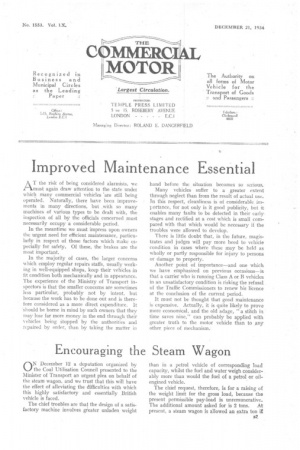Encouraging the Stearn Wagon
Page 21

Page 22

If you've noticed an error in this article please click here to report it so we can fix it.
ON December 12 a deputation organized by the Coal Utilisation Council presented to the Minister of Transport an urgent plea on behalf of the steam wagon, and we trust that this will have the effect of alleviating the difficulties with which this highly satisfactory and essentially British vehicle is faced.
The chief troubles are that the design of a satisfactory machine involves greater unladen weight than in a petrol vehicle of corresponding load capacity, whilst the fuel and water weigh consider-. ably more than would the fuel of a petrol or oil-. engined vehicle.
The chief request, therefore, is for a raising of the weight limit for the gross load, because the present permissible pay-load is unremunerative. The additional amount asked for is 2 tons. At present, a steam wagon is allowed an extra ton if pneumatic-tyred, but it is claimed that it is still at a disadvantage of one ton in pay-load.
It must be remembered that 1,000 steam wagons on the road mean the employment of 650 miners for a whole year, quite apart from the additional work thus created in the handling and transporting of the coal.
We consider that the request is a reasonable one, and sincerely hope that it will receive the consideration it deserves. The Minister has already asked the deputation to produce figures which will enable him to make a detailed comparison of the coal-burning vehicle with its competitors, and has promised to give these his close attention.
Are Cheap Excursions Practicable ?
THE question of the advisability of introducing special day and half-day excursions by coach, at low rates, to combat railway competition, has again arisen and is one that presents several im portant problems. Some large 'concerns operating a number of services have, in the past, found that cheap trips are of little value in increasing traffic, for passengers who would have travelled on the other routes at normal fares were attracted to the special service. Consequently there has been a risk of an ajual decrease in total receipts, whilst the additional traffic created by the concession has been slight. In the case of an operator of only one service, however, an occasional excursion at a reduced fare might well prove to be advantageous, but this would present a serious difficulty.
To be fair to all interests, it would appear that every operator should be permitted to run special excursions. As, however, some larger undertakings would probably not wish for the concession and might well object to its being granted to. others, the prospect of such services being inaugurated on a wide scale seems to be remote.
The financial aspect of the matter also requires careful investigation. The general level of fares is already low and represents value for money unequalled by any other form of transport, consequently it is difficult to see how any drastic reduction can be made, even for isolated excursions, and still earn a profit.
The problems are serious, for the railways are running excursions at ridiculous fares that are doing much harm to the coach operator. To take but one example, the London and North Eastern Railway Co. is charging theatre-goers 3s. for a return journey of 137i miles from Ipswich to London.




























































































